 W
WAlba Mons is a volcano located in the northern Tharsis region of the planet Mars. It is the largest volcano on Mars in terms of area, with volcanic flow fields that extend for at least 1,350 km (840 mi) from its summit. Although the volcano has a span comparable to that of the United States, it reaches an elevation of only 6.8 km (22,000 ft) at its highest point. This is about one-third the height of Olympus Mons, the tallest volcano on the planet. The flanks of Alba Mons have very gentle slopes. The average slope along the volcano's northern flank is 0.5°, which is over five times lower than the slopes on the other large Tharsis volcanoes. In broad profile, Alba Mons resembles a vast but barely raised welt on the planet's surface. It is a unique volcanic structure with no counterpart on Earth or elsewhere on Mars.
 W
WAlbor Tholus is an extinct volcano in the volcanic province Elysium on Mars. It lies south of the neighbouring volcanoes Elysium Mons and Hecates Tholus. Albor Tholus is 4.5 kilometres high and has a diameter of 160 km at its base. Its large caldera, having a diameter of 30 km and a depth of 3 km, is deep compared to calderas on the Earth. The elevation of the lowest level of the caldera is the same as the base of the volcano; however, the original lower slopes of Albor Tholus may have been covered by lava flows from its larger neighbor, Elysium Mons. Evaluations by the Mars probe Mars Express found that the volcanoes of the Elysium region were active over long periods.
 W
WAnseris Mons is an isolated massif (mountain) in the southern highlands of Mars, located at the northeastern edge of Hellas Planitia at longitude 86.65°E and latitude 29.81°S. The mountain is 58 km (36 mi) in diameter and rises to an elevation of approximately 4,200 m (13,780 ft) above datum or about 6,200 m (20,300 ft) above the surrounding plains. The mountain lies in the southeastern quarter of the Iapygia quadrangle (MC-21), straddling the boundary with the adjoining Hellas quadrangle (MC-28) to the south.
 W
WApollinaris Mons is an ancient shield volcano in the southern hemisphere of Mars. It is situated near the equator, south of Elysium Planitia and north of the impact crater Gusev. Elysium Planitia separates it from the volcanic province of Elysium to its northwest. The volcano's caldera is named Apollinaris Patera; this name formerly applied to the whole edifice.
 W
WArsia Mons is the southernmost of three volcanoes on the Tharsis bulge near the equator of the planet Mars. To its north is Pavonis Mons, and north of that is Ascraeus Mons. The tallest volcano in the Solar System, Olympus Mons, is to its northwest. Its name comes from a corresponding albedo feature on a map by Giovanni Schiaparelli, which he named in turn after the legendary Roman forest of Arsia Silva.
 W
WAscraeus Mons is a large shield volcano located in the Tharsis region of the planet Mars. It is the northernmost and tallest of three shield volcanoes collectively known as the Tharsis Montes.
 W
WAusonia Montes is a mountain in the Mare Tyrrhenum quadrangle of Mars, at 25.42° south latitude and 99.04° east longitude. It is 158 kilometres (98 mi) across and was named after an albedo feature name.
 W
WBiblis Tholus is an extinct Martian volcano located at 2.55°N 235.62°E, one of two volcanoes near the center of the Tharsis volcanism. Along with Ulysses Tholus, it is almost midway between Olympus Mons and the Tharsis Montes. Biblis Tholus lies in the Tharsis quadrangle. It is approximately 170 kilometers (110 mi) long and 100 kilometers (62 mi) wide, rising about 3 kilometers (1.9 mi) from its surroundings.
 W
WCentauri Montes is a group of mountains in the Hellas quadrangle of Mars, located at 38.67°S 95.52°E. It is 270 km across and was named after the albedo feature Centauri Lacus.
 W
WCharitum Montes is a large group of mountains in the Argyre quadrangle of Mars, located at 58.4° south latitude and 40.29° west longitude. It is 850 km across and was named after a classical albedo feature name. Charitum Montes has gullies in some areas.
 W
WEchus Montes is a large mountain on Mars at 7.81°N 282.05°E. It is located in the Lunae Palus quadrangle.
 W
WElysium, located in the Elysium and Cebrenia quadrangles, is the second largest volcanic region on Mars, after Tharsis. The region includes the volcanoes Hecates Tholus, Elysium Mons and Albor Tholus. The province is centered roughly on Elysium Mons at 24.7°N 150°E. Elysium Planitia is a broad plain to the south of Elysium, centered at 3.0°N 154.7°E. Another large volcano, Apollinaris Mons, lies south of Elysium Planitia and is not part of the province. Besides having large volcanoes, Elysium has several areas with long trenches, called fossa or fossae (plural) on Mars. They include the Cerberus Fossae, Elysium Fossae, Galaxias Fossae, Hephaestus Fossae, Hyblaeus Fossae, Stygis Fossae and Zephyrus Fossae.
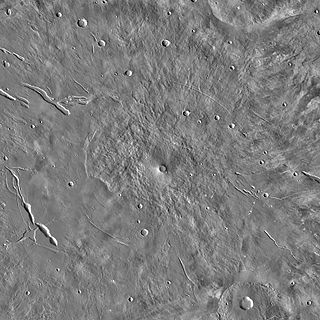 W
WElysium Mons is a volcano on Mars located in the volcanic province Elysium, at 25.02°N 147.21°E, in the Martian eastern hemisphere. It stands about 12.6 km (41,000 ft) above its base, and about 14.1 km (46,000 ft) above the Martian datum, making it the third tallest Martian mountain in terms of relief and the fourth highest in elevation. Its diameter is about 240 km (150 mi), with a summit caldera about 14 km (8.7 mi) across. It is flanked by the smaller volcanoes Hecates Tholus to the northeast, and Albor Tholus to the southeast.
 W
WErebus Montes is a group of mountains in the Diacria quadrangle of Mars, located at 35.66° North and 185.02° West. It is 811 km across and was named after an albedo feature at 26N, 182W.
 W
WGalaxius Mons is a group of mountains in the Cebrenia quadrangle of Mars, located at 34.76 North and 217.69 West. It is 22 km in diameter. The mountain range has a "classical albedo name". The term "Mons" is used for a mountain.
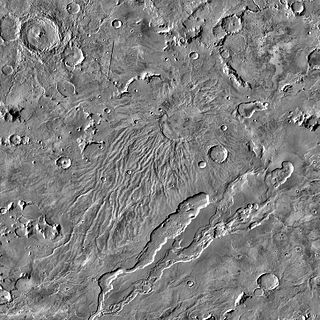 W
WHadriacus Mons is an ancient, low-relief volcanic mountain on the planet Mars, located in the southern hemisphere just northeast of the impact basin Hellas and southwest of the similar volcano Tyrrhenus Mons. Hadriacus Mons is in the Hellas quadrangle. It has a diameter of 450 kilometres (280 mi). The name was approved in 2007. The flanks of Hadriacus Mons have been eroded into gullies; its southern slopes are incised by the outflow channel Dao Vallis. The large extent of volcanic deposits and the caldera size leads some researchers to suggest that these features were the result of an explosive event caused by a contact between magma and groundwater.
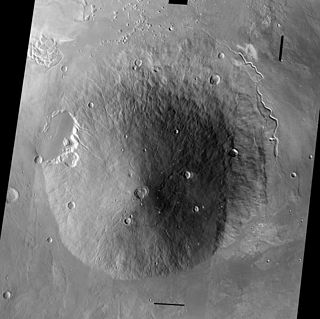 W
WHecates Tholus is a Martian volcano, notable for results from the European Space Agency's Mars Express mission which indicate a major eruption took place 350 million years ago. The eruption created a caldera 10 km in diameter. It has been suggested that glacial deposits later partly filled the caldera and an adjacent depression. Crater counts indicate this happened as recently as 5 to 20 million years ago. However climate models show that ice is not stable at Hecates Tholus today, pointing to climate change since the glaciers were active. It has been shown that the age of the glaciers correspond to a period of increased obliquity of Mars' rotational axis.
 W
WThe Hellespontus Montes is a mountain range on Mars. It stretches 711 km from north to south. It is in the Noachis quadrangle and the southeasternmost area of Noachis Terra, and is located midway between the highland area of Noachis and the impact basin Hellas Planitia. The mountains are named after a Classical albedo feature.
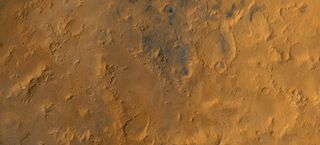 W
WThe Libya Montes are a highland terrain on Mars up-lifted by the giant impact that created the Isidis basin to the north.
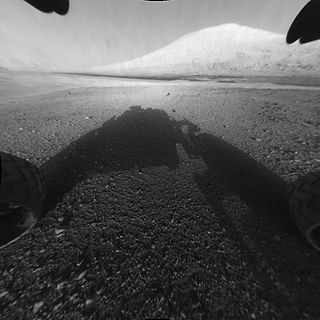 W
WMount Sharp, officially Aeolis Mons, is a mountain on Mars. It forms the central peak within Gale crater and is located around 5.08°S 137.85°E, rising 5.5 km (18,000 ft) high from the valley floor. Its ID in the United States Geological Survey's Gazetteer of Planetary Nomenclature is 15000.
 W
WThe Nereidum Montes is a mountain range on Mars. It stretches 1,143 km, northeast of Argyre Planitia. It is in the Argyre quadrangle. The mountains are named after a Classical albedo feature. Nereidum Montes has gullies in some areas.
 W
WOlympus Mons is a very large shield volcano on the planet Mars. The volcano has a height of over 21 km as measured by the Mars Orbiter Laser Altimeter (MOLA). Olympus Mons is about two and a half times Mount Everest's height above sea level. It is one of the largest volcanoes, the tallest planetary mountain, and the second tallest mountain currently discovered in the Solar System, comparable to Rheasilvia on Vesta. It is often cited as the largest volcano in the Solar System. However, by some metrics, other volcanoes are considerably larger. Alba Mons, northeast of Olympus Mons, has roughly 19 times the surface area, but is only about one third the height. Pele, the largest known volcano on Io, is also much larger, at roughly 4 times the surface area, but is considerably flatter. Additionally, Tharsis Rise, a large volcanic structure on Mars of which Olympus Mons is a part, has been interpreted as an enormous spreading volcano. If this is confirmed, Tharsis would be by far the largest volcano in the Solar System. Olympus Mons is the youngest of the large volcanoes on Mars, having formed during Mars's Hesperian Period. It had been known to astronomers since the late 19th century as the albedo feature Nix Olympica. Its mountainous nature was suspected well before space probes confirmed its identity as a mountain.
 W
WPavonis Mons is a large shield volcano located in the Tharsis region of the planet Mars. It is the middle member of a chain of three volcanic mountains that straddle the Martian equator between longitudes 235°E and 259°E. The volcano was discovered by the Mariner 9 spacecraft in 1971, and was originally called Middle Spot. Its name formally became Pavonis Mons in 1973. The equatorial location of its peak and its height make it the ideal terminus for a space elevator, and it has often been proposed as a space elevator location, especially in science fiction.
 W
WSyrtis Major Planum is a "dark spot" located in the boundary between the northern lowlands and southern highlands of Mars just west of the impact basin Isidis in the Syrtis Major quadrangle. It was discovered, on the basis of data from Mars Global Surveyor, to be a low-relief shield volcano, but was formerly believed to be a plain, and was then known as Syrtis Major Planitia. The dark color comes from the basaltic volcanic rock of the region and the relative lack of dust.
 W
WTharsis is a vast volcanic plateau centered near the equator in the western hemisphere of Mars. The region is home to the largest volcanoes in the Solar System, including the three enormous shield volcanoes Arsia Mons, Pavonis Mons, and Ascraeus Mons, which are collectively known as the Tharsis Montes. The tallest volcano on the planet, Olympus Mons, is often associated with the Tharsis region but is actually located off the western edge of the plateau. The name Tharsis is the Greco-Latin transliteration of the biblical Tarshish, the land at the western extremity of the known world.
 W
WThe Tharsis Montes are three large shield volcanoes in the Tharsis region of the planet Mars. From north to south, the volcanoes are Ascraeus Mons, Pavonis Mons and Arsia Mons. Mons is the Latin word for mountain; it is a descriptor term used in astrogeology for mountainous features in the Solar System.